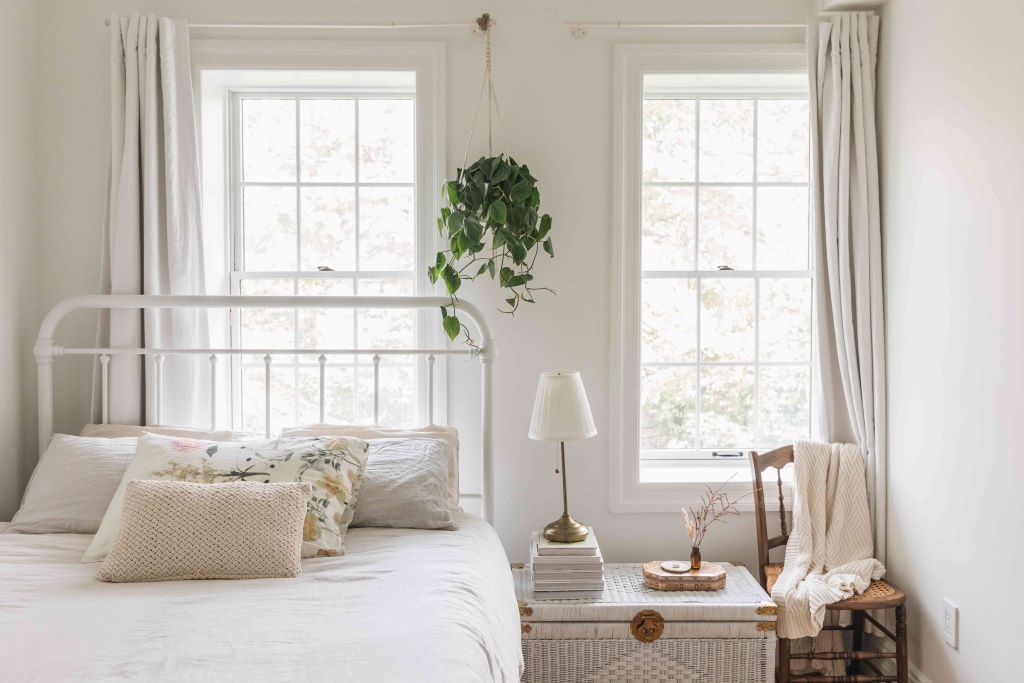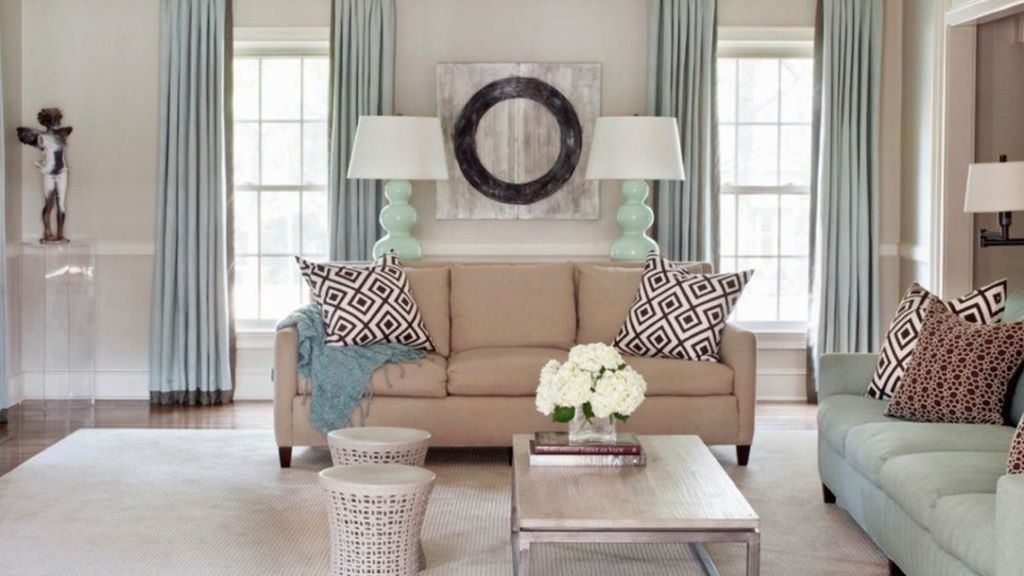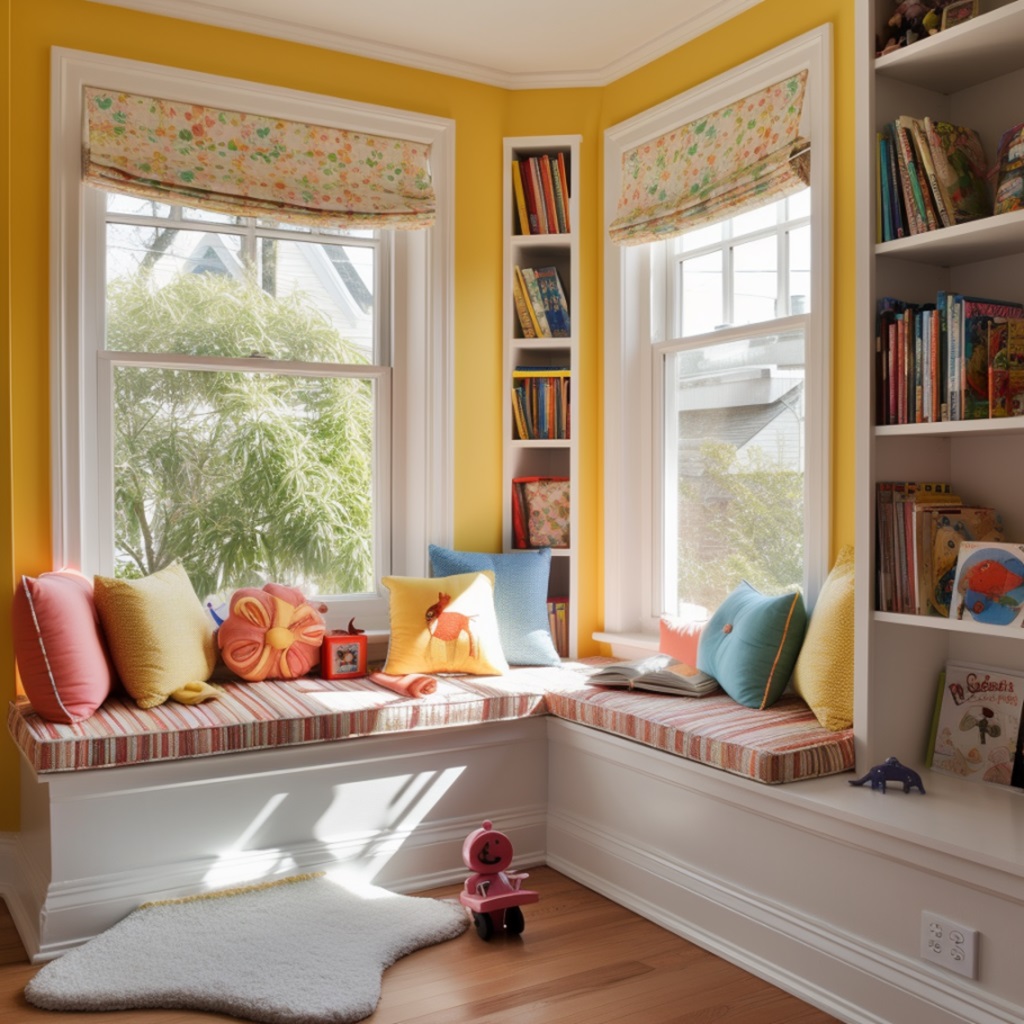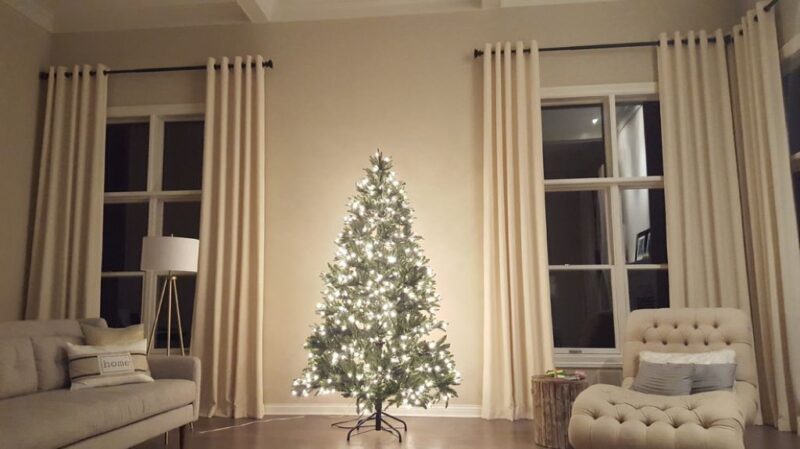When we look at the space between two windows in a room, it can seem like an awkward and useless area that doesn’t serve any purpose. However, with some creativity, this space can be transformed into something both practical and aesthetically pleasing. One option is to install a window seat, which not only adds extra seating but also provides a cozy spot for reading or relaxing. Another idea is to use the space as a display area for plants, books, or decorative items, adding a touch of greenery or a pop of color to the room.
If the space is wide enough, it can even be used as a small workspace, with a desk and chair tucked neatly between the windows. There are countless possibilities for making the most of this often-overlooked space, and with a little bit of imagination, it can become a highlight of the room. In this article, we’ll explore several ideas to help you make the most of the space between your windows.
Add a Display Shelf
One of the simplest ways to utilize the space is to install floating shelves. Opt for sturdy shelves in a natural wood tone or painted a crisp white. Use the shelves to display meaningful mementos, decorative objects, houseplants, books, and more. Stagger the placement and vary heights for visual interest. Shelving offers a perfect spot for greenery that will bask in the ample sunlight streaming between windows.
To highlight the windows, resist covering the entire space in shelving. Leave negative space between shelves or place them only at the top and bottom. This transforms the shelving itself into an artful display. For a cohesive look, match the shelves to other wood elements in the room, such as flooring or window frames.

Create a Home Office Nook
The space between two windows makes for the ideal little home office nook. Add a small desk that fits snugly between the windows. Top it with a minimalist desk lamp, a potted plant, and office supplies stored in cute containers. The windows will wash the desk in natural light, creating an inspiring place to work.
For more privacy, discover what to put between two windows in living room, consider installing blinds or curtains on the windows. White sheer curtains are an excellent choice as they allow light through while obscuring the view. If the nook will be visible, take extra care to style it in an organized and attractive way. A bulletin board hung horizontally above the desk offers a place to pin inspiration.
Craft a Reading Nook
Transform the space into a cozy reading nook by positioning a comfy chair or loveseat between the windows. Stack the floor next to the seating with piles of pillows and blankets to complete the snug atmosphere.
This reading nook will feel like a secret escape yet still connect you to the rest of the room through the windows on each side. To immerse yourself in a good book, hang a swing arm sconce above the seating for a direct pool of light. Add a floor lamp behind the chair to prevent eyestrain.
For extra flair, frame the windows with curtains or drapes. The billowing fabric amplifies the coziness and sense of privacy. Choose a vibrant print or color to contrast the neutral window shades.
Build Out a Window Seat
One way to fully utilize the space is to construct a built-in window seat. This classic architecture detail extends the seating area while accentuating the windows. Opt for a bench depth of at least 20 inches for comfort. Store blankets and pillows inside for convenience.
Outfit the window seat with cushions covered in your color scheme of choice. Patterned fabric adds visual interest when viewed through the windows. For a casual feel, use washable cotton slipcovers that can be easily changed with the seasons.
Flank each side of the seat with architectural columns or built-in bookcases for balance. Lighting above or beside the seat enables you to nestle in with a book. Add a pop of greenery on the seat or an adjacent side table to connect the indoor and outdoor views.
Hang a Macrame Wall Hanging
An easy way to decorate and draw attention to the windows is hanging a macrame wall hanging in between. Choose natural fiber tapestries with muted neutral and earth tones. The woven texture and organic shapes pair nicely with the geometric lines of the architecture.
Hang the macrame piece an appropriate height so it doesn’t block the windows. Layer the wall hanging with similarly textured elements like rattan shades or linen curtains. The negative space around the woven artwork spotlights the windows themselves.
For a serene atmosphere, opt for a nature-inspired pattern like leaves or geometric shapes. Or pick a mandala or abstract linear design with calming colors like cream, tan or pale blue. A larger macrame piece can make a real statement while keeping the windows visually open.
Create Display Space with Picture Ledges
Picture ledges offer both form and function for this awkward space. Mount ledges horizontally above the windows in a floating formation. Use the ledges to display framed photos, art, mirrors, candles, and any other decorative objects.
Paint the picture ledges white to recede into the wall and draw attention to the items on display. For a bold accent, opt for ledges with metallic finishes like brass or chrome.
Arrange the ledges asymmetrically at varying heights. Include some negative space between ledges and items to prevent looking cluttered. The ledges become like an art installation framing the glass.
Install Wallpaper or Paneling
Dress up drab walls with wallpaper or paneling placed between the windows. Opt for patterns like an intricate damask, ikat print or toile to elevate the traditional windows. Play with contrasting colors and textures to create an eye-catching focal point.
For a more subtle and seamless look, try grasscloth wallpaper. Its mottled, woven texture provides natural variation. The raw, organic motif pairs well with classic architecture and doesn’t distract from the windows themselves.
Wall paneling lends dimension and architectural interest. Stick to clean lines and traditional materials like painted wood or tile for a built-in look. Add molding along the edges for depth and character. Wallpaper or paneling transforms boring walls into a beautiful backdrop.

Make a Gallery Wall
Turn the space into a gallery wall to show off your favorite art, prints, photographs or keepsakes. Start by painting the wall between the windows a neutral shade like gray or tan to offset the framed pieces. Prioritize proper placement and spacing between items over filling the entire space.
Mix different frame sizes, colors and styles for visual interest. Cluster some items together and stagger others. Install picture ledges and shelves for dimensional layers. Include greenery and decor items like sculptures or candleholders for added depth.
Illuminate your gallery wall with mounted lighting or sconces. This highlights the artwork while preventing shadows and glare. Let some blank wall show to prevent a cluttered feeling. Update and swap pieces out seasonally for a fresh look.
Add Mirrors for Light and Space
Hang mirrors between windows to reflect light and create the illusion of more space. Floor mirrors visually expand a small area. Lean them against the wall for a casual vignette or anchor them for stability.
For a lighter look, hang two mirrors with thin wood frames in matching or coordinating finishes. Leave negative space between the mirrors to prevent looking crowded. Opt for oval or circular mirrors for a playful pop.
Or fill the whole space by mounting one large rectangular mirror. This bounces ample light around the room and seamlessly blends with the windows on each side. Consider beveled edges or dimmable lighting along the frame for ambiance during evening hours.
Install Patterned Window Film
Add a new dimension to plain windows using decorative window film. These translucent vinyl sheets easily adhere to glass and come in a variety of patterns. Opt for an etched glass, faux stained glass or rice paper look.
Or try abstract shapes, floral designs and geometric patterns. The colored film filters sunlight in an artistic way. Use window film to tie patterned curtains, wallpaper or upholstery into a cohesive theme.
Change it up for the seasons or holidays by switching out the film. during summer opt for a coastal or tropical motif. In winter go for frosted snowflake or evergreen themes. Window film allows you to alter the look without renovations.
Showcase Houseplants
The ample natural light streaming between windows provides ideal conditions for raising houseplants. Take advantage of the built-in ledge to display potted greenery. For a cohesive look, use planters and pots that coordinate with the overall decor.
Mix trailing vines, standing leafy plants and succulents for varied heights and textures. Leave some negative space between plants to prevent looking crowded. Consider installing shelving above the ledge for more space to grow your urban jungle.
Let vines drape down along the windows or walls for a living curtain. Position taller leafy plants on stands in front of the windows. The surrounding windows will nourish plants while the greenery softens the hard edges.
Add Architectural Columns
Span the space between windows with the addition of architectural columns. Opt for rounded polished marble or granite pillars for a glamorous accent. Or try square-edged columns clad in reclaimed wood planks for a rustic outdoor feel.
The columns instantly create the illusion of a larger, grander architectural space. Flank them with container plants, sconces or statues on pedestals for dramatic effect.
Paint or finish the columns in a hue that matches accents like the window frames, light fixtures or flooring. Columns can make an awkward empty space feel infinitely more special.
Install Floor-to-Ceiling Drapes
Another way to treat troublesome window gaps is installing floor-to-ceiling drapes that span the entire space. Fully covering the area from wall-to-wall and ceiling-to-floor gives the appearance of a taller, expansive window.
Choose rod-pocket curtain panels made from luxe fabrics like velvet, linen or brocade in rich hues. Drawing the drapes open and closed accentuates their height and grandeur. Stack them open during the day to allow sunlight through.
At night, close the dramatic curtains to amplify coziness and intimacy. Dim lighting behind the curtains creates a soothing ambiance and casts beautiful shadows. Accent with decorative tiebacks and coordinating window shades.
Add Bold Wallpaper
Make a stylish splash by wallpapering the entire space between windows in an eye-catching print or vibrant color. For a luxurious accent wall, opt for baroque-inspired damask, chinoiserie motifs, or metallic grasscloth texture.
Or try handpainted murals depicting lush outdoor scenery and landscapes. This unexpected wall covering transports you and expands the feel of the room. The bold papered wall becomes the focal point, while the unadorned windows frame the view beyond.
Consider framing the wallpapered section with wood trim for a paneled effect. Complement with curtain colors and throw pillows that pick up hues from the vibrant pattern. The wallpapered window space becomes an instant conversation piece.
Arrange a Textile Art Display
The window ledge provides the ideal narrow stage to exhibit an array of textile arts and crafts. Drape handmade quilts, blankets, wall hangings and tapestries over the ledge and allow them to hang down. Or fold and stack vintage French grain sacks, blanket ladders and quilts.
Surround vignettes with potted plants, antlers, baskets or books for a layered look. Incorporate a chest, stool or table to create dimension. Use this space between windows to proudly display heirloom textiles and handicrafts.
Their textured patterns and colors will glow beautifully within the streaming sunlight. Change them out seasonally or for holidays.
Floating Shelves for Plants and Books
Another way to build out the space is installing floating shelves. Use them to display potted plants intermixed with books, photos and collected treasures. The mix of textures and colors make for an inviting vignette.
Paint the backdrop wall an energetic hue like cobalt, chartreuse or berry. Opt for unfinished wood shelves with visible grain that blends with decor like woven baskets and ceramic pots. Float shelves at staggered heights for more visual interest than one long straight ledge.
Let houseplants take center stage on the sunny shelves. Intersperse decor items on some shelves and leave others empty to prevent clutter. The organic styling of the shelves prevents distracting from the windows as the focal point.
Add a Fold-Down Desk
For a space-saving solution, install a fold-down desk that tucks away when not in use. Opt for a slim, wall-mounted desk that folds up and down vertically. When folded up, it will be flush with the wall and out of sight.
Look for desks with a smooth,easy folding mechanism and a neutral melamine, laminate or stained wood finish. Incorporate useful features like open shelving to hold office supplies and a corkboard to pin reminders.
When folded down, the compact desk provides the perfect landing spot for a laptop, notebook and cup of coffee. Let the ample sunlight provide an invigorating space to tackle the to-do list, pay bills or work on hobbies. Then fold it back up when the work is done.
Incorporate Architectural Molding
Define the space with elegant architectural molding designs. Install crown molding where the walls meet the ceiling. Box out a paneled design with picture frame or chair rail molding. Finish it off with simple baseboards at floor level.
Opt for wide, ornate moldings for a grand appearance. Traditionally designed styles like rope or egg and dart exude timeless sophistication. Match the molding finish to other wood elements like floors or window frames for harmony.
The trim frames the window space beautifully without competing for attention. Accentuate with wall sconces, artwork or mirrors surrounded by the ornate moldings.
Hang Window Box Planters
Bring the outdoors in by installing window boxes overflowing with blooms. Mount them right beneath the windowsills outside and allow the colorful flowers to cascade down. Opt for classic steel boxes or rustic wooden designs. Self-watering window boxes make care easy.
Plant seasonally appropriate varieties like purple pansies in winter and red geraniums in summer. Go for a mix of trailing lobelia, petunias, impatiens and other sun-loving annuals. Their lively colors and natural beauty frame views outdoors.
Completing the windowscape with cheery blossoms and greenery enhances curb appeal. As an added bonus, the flowers help filter harsh sunlight. Open the window to enjoy their perfume on breezy days.
Add Matching Window Valances
Treat plain windows to elegant window valances that visually unite the two windows. Cut custom valances to span the entire space, or opt for two matching readymade designs. Select rich fabrics like brocade, damask or embroidered silk.
For a tailored look, try thick box-pleated valances in lush velvet or cotton. Or go for soft ruffled or swagged valances for a romantic vibe. Include decorative trim like ruffles, tassels, braid or banding along the lower edge.
Match or coordinate the valances to existing curtains or blinds. Install them right above the window frames to accentuate the architecture. Valances amplify the windows’ grandeur and cohesively blend the two windows with their repetitive form.
Make a Palette Wall with Shelves
Get creative with an artsy palette wall made from recycled wood. Use reclaimed boards, crates, barn wood or fencing to make a textured backdrop. Leave an inch between each plank for definition. Sand and seal the wood but leave visible imperfections.
Set boards vertically or horizontally for different effects. Float shelves made from additional reclaimed wood to hold collections and treasured finds. Opt for open box shelves, ladder shelves or simple ledges.
The organic wood backdrop warms up the sleek windows and provides creative display space. Accent shelves with potted succulents, candles, baskets and framed photos. Switch out what’s on display for endless options with the rustic palette wall.

Frame with Wall Sconces or Lanterns
Strategically placed sconces or lanterns flanking the windows infuse ambiance and accentuate the architecture. Opt for matching fixtures on each side to create symmetry and harmony. Consider lanterns or sconces with transparent glass panels to allow some light through.
Choose an ornate style like wrought iron or antique brass for a glamorous surround. Install dimmable, downlight sconces to prevent glare and illuminate the space at night. Upward facing sconces can provide soft ambiance without shadows.
Sconces also work nicely above taller windows to amplify their lofty presence. Their warm, ambient light contrasts beautifully against daylight.
Arrange a Multi-Tiered Plant Display
Show off your greenery obsession by arranging an indoor multi-tiered plant display between windows. Use a mix of stands, tables, crates, ladders and shelves for height variation. Top with an array of potted plants like trailing ivy, flowered orchids and leafy fronds.
Paint the background wall a deep green to complement the abundant flora. Consider installing shelving to provide more surfaces for displaying plants. Try arranging them on the window sills as well.
The foliage framed by the windows creates a soothing, peaceful atmosphere. As the plants prosper in the ample sunlight, they’ll trail gracefully along the walls and windows. Remember to include decor accents like candles and ceramic pots.
Incorporate Cafe-Style Curtains
For a casual, laidback vibe try cafe-style curtains between windows. These relaxed curtains only cover the lower half of the windows. They allow light through while obscuring views and blocking glare.
Opt for breezy, natural fabrics like linen, cotton or jute. Crisp stripes and fun patterns like polka dots or plaids add personality. Incorporate useful features like pockets, corner tiebacks and grommets.
Hang them high and wide to cover most of the lower window frames. Pair with additional window treatments like blinds or shutters on upper halves for full privacy. Keep the look light and airy to contrast the serious mood of heavy draperies.
Try Wall-Mounted Bookshelves
Wall-mounted bookshelves provide a space-savvy storage solution for books, photos and decor between windows. Opt for basic floating shelves, ladder-style designs, or more traditional shelving units with sideboards. Include usable space underneath with a pull-out desk or drawers.
Paint the shelves in a crisp, bright white to blend seamlessly with walls. Or choose natural wood with an organic shape and visible grain for contrast. Arrange items sparingly for a clean look that won’t obscure the windows.
Incorporate vertical elements like candles and vases to direct eyes upwards. Try sconces or pendant lamps above the shelves for ambiance. Wall shelves keep items organized and on display in a narrow area between windows.
Add a Room Divider
Define and divide a long space with a decorative screen or room divider between windows. Freestanding dividers provide privacy and hide clutter without permanent
construction. Opt for lightweight natural fiber screens like rattan, bamboo, jute or seagrass. Or try fabric room dividers mounted on folding acrylic or wood panels.
For an open airy feel, consider lattice-style dividers made from overlapping wood slats. They filter light beautifully while still allowing views through.
Or frame bold indigo dyed fabric or patterned wallpaper in a panel divider. The eclectic artwork doubles as functional space delineation.
Stand dividers on the floor or hang them. Use to section off workspaces, conceal storage areas, or add textural intrigue. Dividers soften hard edges and make large spaces feel intimate. Their layered forms contrast the glassy windows.
Build a Window Seat Underneath
Maximize unused space below the windows with built-in bench seating. Construct a platform topped with cushions to create an instant window seat. Include storage underneath for blankets, games or books.
Build the window seat using materials that match the rest of the room, like reclaimed wood or polished stone. Outfit with thick foam and washable cotton cushions. Position near an additional light source for reading comfort.
The cozy window perch framed by large windows feels like a little hideaway with a view. Add throw pillows and an area rug underneath for a thoughtfully styled lounging spot. Build in bookshelves or cabiets for more functionality.
Try Patterned Wallpaper Behind
Make the windows pop with vibrant patterned wallpaper installed on the wall behind them. Bold graphic prints, modern geometrics or playful motifs add energy while allowing the windows to shine. Avoid overwhelm with organic patterns like illustrative leaves or painterly florals.
Consider grasscloth or textured wallpapers for added depth and architectural contrast on the flat wall. Framing patterned papered walls with neutral curtains and woodwork keeps the focus on the windows themselves.
Let the lively colors and patterns reflect outside to interior views and add privacy. Change it up for a fresh revamp simply by switching out the wallpaper design. This colorful backdrop transforms plain windows into an artistic showpiece.
FAQs
What are some good options for utilizing the awkward space between two windows?
Some great ways to use the space include building shelves or window seats, creating a cozy reading nook, installing curtains or wallpaper, displaying plants or artwork, adding a desk or office area, making a gallery wall, or incorporating architectural elements like columns or molding.
What are some tips for styling and decorating the space between windows?
Decorate the space simply without going overboard. Leave some negative space and avoid clutter. Choose neutral backgrounds to let items on display pop. Incorporate lighting sconces or pendants. Use decor items that harmonize with your overall room scheme. Keep styles cohesive by repeating colors, textures and materials.
How can I make the most of natural light between windows?
Face chairs, desks and shelving perpendicular to the windows to get ample lighting. Use mirrors and reflective surfaces to bounce light around. Try translucent curtains to filter light. Position taller plants on stands near windows. Opt for light open styles like cafe curtains over heavy drapes. Install dimmers on lighting fixtures to adjust brightness.
What are some good storage solutions to add between windows?
Some great storage options include floating shelves, ladder shelves, cubbies, cabinets, drawers, window seats with hidden storage, desk nooks, bookshelves, and wall file racks. Baskets, trunks, and decorative boxes can hold items without looking cluttered.
How do I decorate the space but still highlight the windows as a focal point?
Avoid covering up the windows completely. Leave negative space around and between items on display. Use neutral wall colors as a blank backdrop for decor. Frame the windows with clean-lined curtains and valances. Spotlight architecture by hanging sconces and artwork around the windows. Keep window treatments and shelving low enough not to obstruct the view.
Conclusion
The often overlooked space between two windows presents a decorating challenge but also provides exciting possibilities. With creativity and style, you can transform this awkward gap into a functional feature that enhances your room. An inviting reading nook, stylish built-ins, or lush indoor garden breathe new life into the unused area.
When tackling the space, focus on choosing cohesive designs and versatile furnishings. concentrating lighting and storage solutions in this unused spot helps extend your living area. Enhance your property’s value by investing in impact-resistant windows, a wise choice for durability and safety. Approach the surrounding area as an opportunity to elevate seasonal style with quick updates like decoration accents, textiles, and greenery, ensuring that your thoughtful decor complements rather than detracts from the impact-resistant windows that stand as the focal point of your home. With an inventive vision, this challenging space can become one of the most charming aspects of your room.

